In the world of mobile app development, there is one constant metric that is always being measured and tweaked – session length. The average user spends only a few minutes on an app before moving on to something else, which is why it’s important for businesses to focus on ways to keep users engaged and spending more time in their app. In this blog post, we will discuss some methods you can use to increase your session length. Keep reading to learn more!
What Is Session Length?
Session Length is the amount of time from when a user launches the app until they terminate their usage. It records the duration of an individual’s uninterrupted interaction with the application. Depending on the sort of app, Session Length can be tailored to specific needs. For instance, a streaming app may timeout after a certain duration or track time running in the background.
By measuring Session Length, app developers can better understand how long users are engaged with their app and make changes accordingly to improve the user experience. In doing so, they can also optimize advertising placements and better monetize their app. Ultimately, understanding Session Length is crucial for any app developer who wants to ensure that their app is successful.
Why Is Session Length Important For Mobile Apps?
Session length is an important metric for mobile app developers and marketers to pay attention to because it indicates the quality of the user experience. This can provide valuable insight into how users interact with the app, which can help inform design and development decisions.
Session length is also important when it comes to user retention, as longer sessions tend to lead to more engagement with the app and a greater likelihood of returning users.
By monitoring session lengths, developers can track how users interact with the app over time, make changes where necessary, and measure its effectiveness. A
Additionally, session length can be used as a benchmark to compare the performance of different versions of an app. This can help developers identify where improvements need to be made and which features are most successful.
Ultimately, understanding session lengths is essential for creating mobile apps that offer a great user experience and encourage users to come back again and again.
How Do You Calculate Session Length?
Session Length is the amount of time a user is actively using your app. You can calculate it by subtracting the time the app was launched from the time the user becomes inactive. This should be customized to fit your app type and objectives.
For example, if you want to calculate the Session Length for an e-commerce app, you would want to take into account not only when the user puts down their device, but also when they close the app or leave the site.
Here’s the formula:
Time user becomes inactive – time app was launched = (#) Session Length
Factors That Affect Session Length
There are many factors that affect the session length of your mobile app. Some of those include:
User Engagement:
The level of engagement that a user has with an app will have a big impact on how long their session is. If users are highly engaged, they’re more likely to stay within the app longer than those who aren’t as interested.
Location-based Services:
If an app uses location-based services, this can affect the user’s session length. For example, if a user is using an app to find stores in their area or services around them, they may be more likely to stay within the app for longer as they search for what they need.
Relevancy:
If an app is relevant to the user’s needs, it may cause them to stay on for longer as they find what they need. If an app has a lot of useless content or features that don’t hold any relevance to the user, this can lead to shorter sessions.
Features:
The features included in an app will also have an effect on session length. If users can easily find what they’re looking for and the features are intuitive, this will naturally lead to longer sessions. However, if the navigation is confusing or unintuitive, this could cause user frustration which may lead to shorter sessions.
Design:
The design of an app is another factor that affects session length. If an app is aesthetically pleasing and easy to navigate, this can lead to longer sessions as users explore the content. On the other hand, if an app has poor design or a confusing layout, users may become frustrated and leave after a short period of time.
Performance:
Finally, the performance of an app also affects how long users stay within the app. If an app is slow to load or has frequent crashes, this can lead to shorter sessions as users become frustrated and move on. App performance should be optimized in order to keep users engaged for longer periods of time.
By taking the time to understand and optimize each of these factors, developers can ensure that users stay within their apps for longer periods of time. This can lead to more engagement, higher user retention rates, and ultimately, more success for their mobile app.
How Can You Visualize Session Length?
Single Value Chart
A single-value chart in the dashboard is a great place to start with the visualization of session length. This chart will show the raw statistic, as well as an additional number and symbol that indicates how much higher (or lower) it is compared to the previous time period.
Line Graphs
Line graphs can also be used to visualize session length, allowing for comparison across multiple time periods so that trends or seasonal changes in user behavior can be identified. It’s also a great way to compare performance over time, such as if you are measuring the impact of a new feature or marketing campaign.
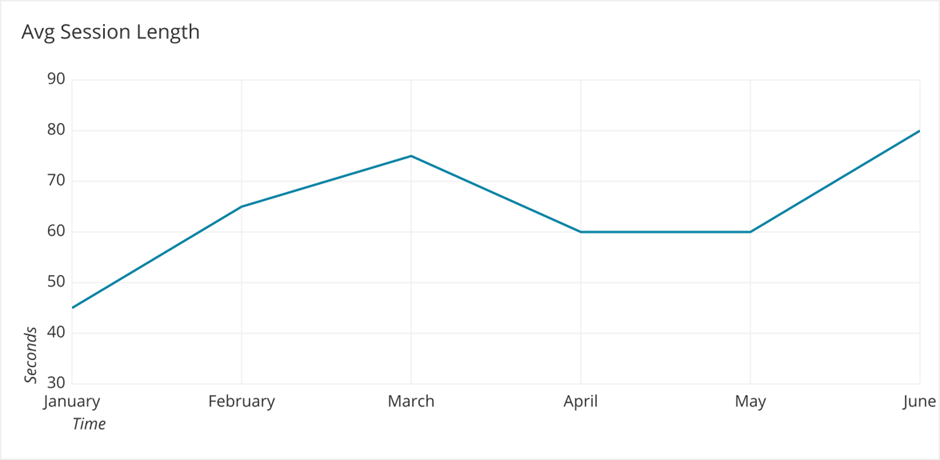
Histograms
Histograms provide another way to view session length. This chart type provides a visual summary of the distribution of values, showing how often each value occurs. This can give you insight into where most users are spending their time and which areas need more attention.
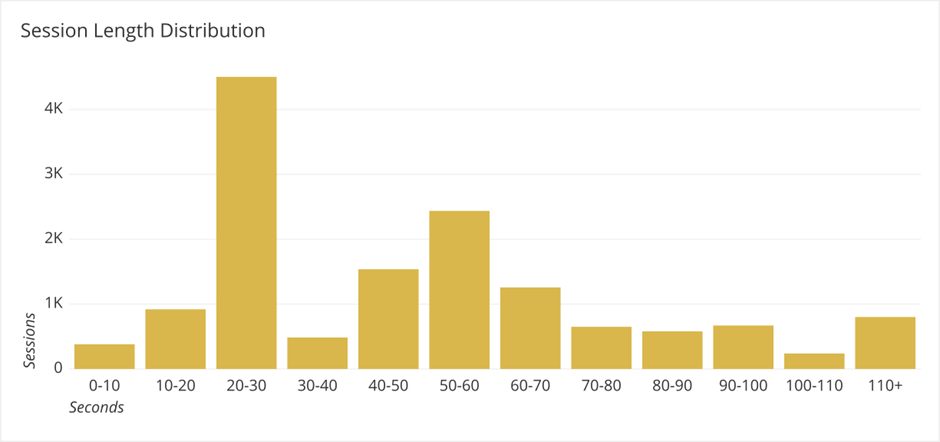
Advice From Mobile Experts
As app publishers, it is essential to assess whether your app’s mission is best served with long-term engagement or shorter user interactions. Although there are many metrics for measuring engagement, session length can be one of the most powerful indicators. According to Henry Cipolla, Chief Technology Officer at Localytics, “Session length is not the only metric for measuring engagement, but it is one that really matters.” Determining an ideal session length for your app can be beneficial in optimizing user experience, understanding usage patterns and developing a successful monetization strategy.
What Is A Good Session Length?
The average session length of mobile users is around five minutes, however, this may vary depending on the category of business. It is therefore important to not be deceived by thinking that longer session lengths equate to success; instead, focus on following benchmarks for the particular category and observing historical and seasonal trends.
If you are developing a product delivery app, having long sessions may suggest there is an issue with the user experience. On the other hand, game applications need to have longer session lengths to determine if they are engaging and interesting for users.
According to data collected by Adjust and reported in a Statista report, average session durations were observed to vary according to vertical in 2019 and 2020, as shown in the graphic below.
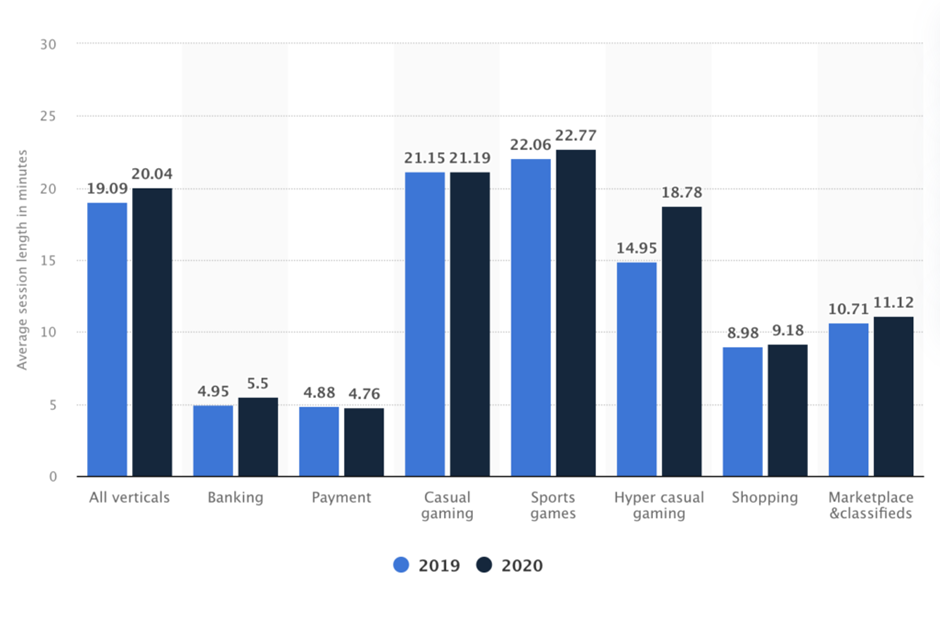
Examples Of Session Length
The importance of session length can be illustrated by comparing two example apps.
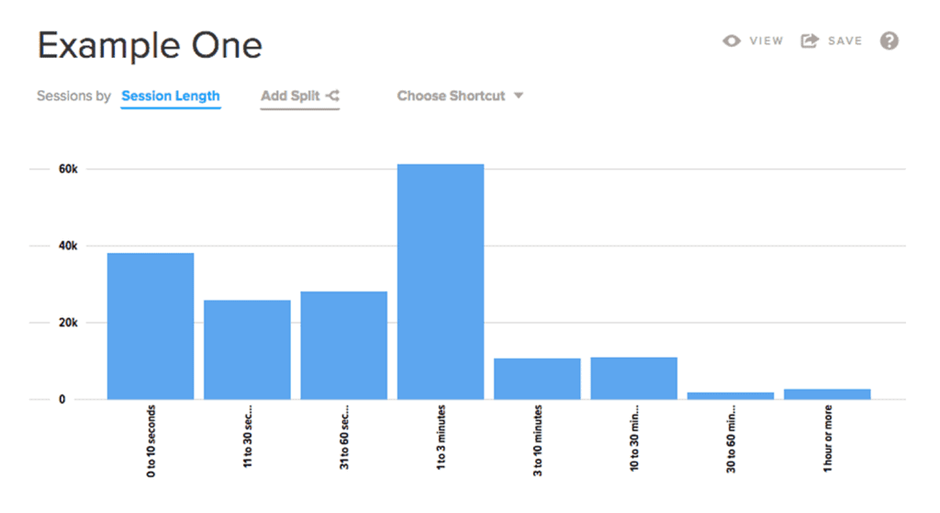
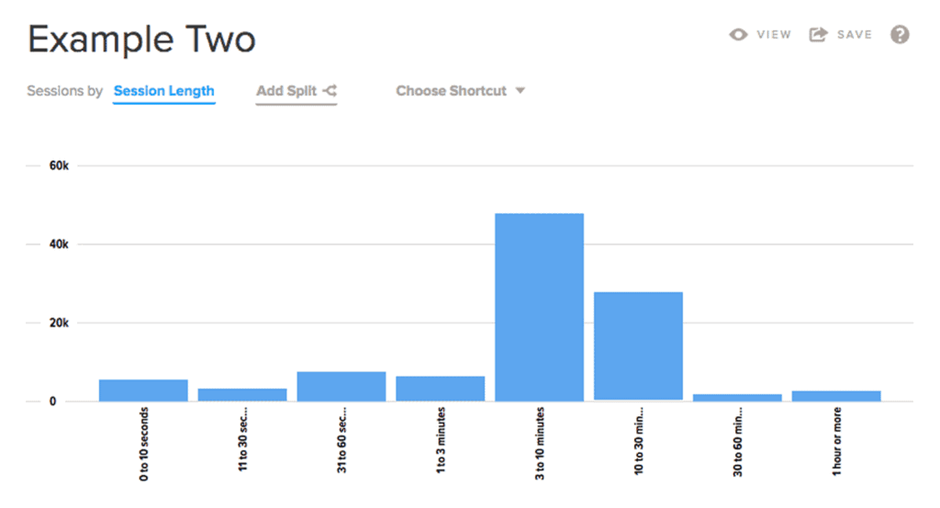
For instance, users of Example Two spend longer in the app than those using Example One. On average, most sessions, for example, Two last longer than three minutes whereas the majority, for example, one are shorter than three minutes. At first glance, this would suggest that Example 2 is more engaging and thus better.
However, it is not necessarily the case. If both apps are content-related, then Example Two could indeed be more successful in user engagement. But if one is a taxi-finding app, then a session lasting one minute may be preferred over one that takes 10 minutes.
It is important to understand whether or not the app’s mission is best served by keeping users in the app for as long as possible, or if it is more beneficial to return them back quickly. Only with precise knowledge of session length can app publishers make this determination. A media app’s success may be measured in time spent reading, while a taxi service should aim for the minimum time taken to locate a ride.
Strategies To Improve The Session Length Of Your Mobile App
Implement a Feedback System:
Encourage users to provide feedback on their experience with your mobile app. Ask open-ended questions that focus on the user’s journey and how they felt about certain aspects of the app. This will help you identify potential problems and areas for improvement to increase session length.
Offer Personalized Content:
Personalizing content for individual users is a great way to keep them engaged and interested in your mobile app. Use user data to recommend relevant products, services, or experiences that are tailored to their interests. This will help extend the session length and make the overall experience more satisfying.
Utilize Push Notifications:
Let users know when there is something new or exciting on your app, such as a sale, feature update, or content related to their interests. Push notifications will remind users to come back and engage with your mobile app.
Create Gamification Elements:
Gamifying your app by incorporating challenges or levels can be a great way to keep users engaged and increase session length. It also provides an opportunity to reward users for completing tasks, which will make them more likely to return to your app.
Improve App Performance:
A slow-loading app is one of the biggest factors that can decrease session length. Make sure that you are regularly testing and optimizing your app’s performance by focusing on page loading times and reducing lag. This will help ensure that users have a smooth experience and don’t become frustrated with your app.
Use Analytics to Identify Areas of Improvement:
Using analytics tools will give you valuable insights into user behaviour, such as when they are most likely to engage with your app, what types of features they are using, and how long they tend to stay on your app. This data can help you identify areas for improvement to increase session length.
Use A/B Testing:
Utilize A/B testing to measure the impact of different changes on user engagement. For example, if you want to see which color scheme has the greatest impact on session length, you can create two versions of your app and test them among users. This will give you concrete data to inform future changes.
Overall, it is important to constantly review and optimize user experience in order to increase session lengths. By utilizing the strategies mentioned above you can create a more engaging mobile app that drives user loyalty.
Conclusion
By utilizing some of the methods we’ve discussed in this blog post, you’ll be able to increase your session length and improve user engagement on your website.

